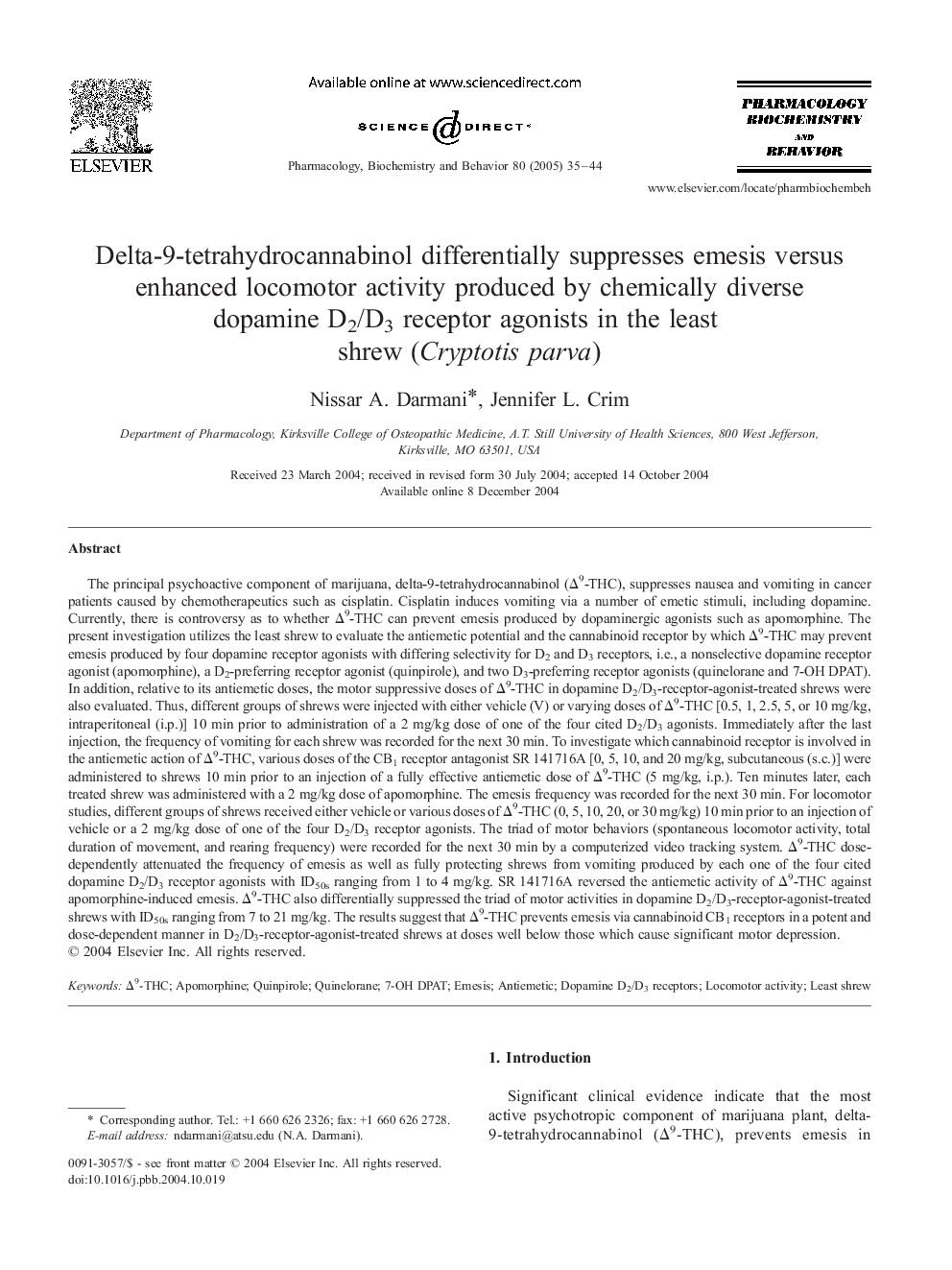| کد مقاله | کد نشریه | سال انتشار | مقاله انگلیسی | نسخه تمام متن |
|---|---|---|---|---|
| 10838581 | 1067172 | 2005 | 10 صفحه PDF | دانلود رایگان |
عنوان انگلیسی مقاله ISI
Delta-9-tetrahydrocannabinol differentially suppresses emesis versus enhanced locomotor activity produced by chemically diverse dopamine D2/D3 receptor agonists in the least shrew (Cryptotis parva)
دانلود مقاله + سفارش ترجمه
دانلود مقاله ISI انگلیسی
رایگان برای ایرانیان
کلمات کلیدی
موضوعات مرتبط
علوم زیستی و بیوفناوری
بیوشیمی، ژنتیک و زیست شناسی مولکولی
زیست شیمی
پیش نمایش صفحه اول مقاله

چکیده انگلیسی
The principal psychoactive component of marijuana, delta-9-tetrahydrocannabinol (Î9-THC), suppresses nausea and vomiting in cancer patients caused by chemotherapeutics such as cisplatin. Cisplatin induces vomiting via a number of emetic stimuli, including dopamine. Currently, there is controversy as to whether Î9-THC can prevent emesis produced by dopaminergic agonists such as apomorphine. The present investigation utilizes the least shrew to evaluate the antiemetic potential and the cannabinoid receptor by which Î9-THC may prevent emesis produced by four dopamine receptor agonists with differing selectivity for D2 and D3 receptors, i.e., a nonselective dopamine receptor agonist (apomorphine), a D2-preferring receptor agonist (quinpirole), and two D3-preferring receptor agonists (quinelorane and 7-OH DPAT). In addition, relative to its antiemetic doses, the motor suppressive doses of Î9-THC in dopamine D2/D3-receptor-agonist-treated shrews were also evaluated. Thus, different groups of shrews were injected with either vehicle (V) or varying doses of Î9-THC [0.5, 1, 2.5, 5, or 10 mg/kg, intraperitoneal (i.p.)] 10 min prior to administration of a 2 mg/kg dose of one of the four cited D2/D3 agonists. Immediately after the last injection, the frequency of vomiting for each shrew was recorded for the next 30 min. To investigate which cannabinoid receptor is involved in the antiemetic action of Î9-THC, various doses of the CB1 receptor antagonist SR 141716A [0, 5, 10, and 20 mg/kg, subcutaneous (s.c.)] were administered to shrews 10 min prior to an injection of a fully effective antiemetic dose of Î9-THC (5 mg/kg, i.p.). Ten minutes later, each treated shrew was administered with a 2 mg/kg dose of apomorphine. The emesis frequency was recorded for the next 30 min. For locomotor studies, different groups of shrews received either vehicle or various doses of Î9-THC (0, 5, 10, 20, or 30 mg/kg) 10 min prior to an injection of vehicle or a 2 mg/kg dose of one of the four D2/D3 receptor agonists. The triad of motor behaviors (spontaneous locomotor activity, total duration of movement, and rearing frequency) were recorded for the next 30 min by a computerized video tracking system. Î9-THC dose-dependently attenuated the frequency of emesis as well as fully protecting shrews from vomiting produced by each one of the four cited dopamine D2/D3 receptor agonists with ID50s ranging from 1 to 4 mg/kg. SR 141716A reversed the antiemetic activity of Î9-THC against apomorphine-induced emesis. Î9-THC also differentially suppressed the triad of motor activities in dopamine D2/D3-receptor-agonist-treated shrews with ID50s ranging from 7 to 21 mg/kg. The results suggest that Î9-THC prevents emesis via cannabinoid CB1 receptors in a potent and dose-dependent manner in D2/D3-receptor-agonist-treated shrews at doses well below those which cause significant motor depression.
ناشر
Database: Elsevier - ScienceDirect (ساینس دایرکت)
Journal: Pharmacology Biochemistry and Behavior - Volume 80, Issue 1, January 2005, Pages 35-44
Journal: Pharmacology Biochemistry and Behavior - Volume 80, Issue 1, January 2005, Pages 35-44
نویسندگان
Nissar A. Darmani, Jennifer L. Crim,